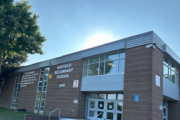DEERBROOK, Wis. (AP) — Jeremy Solin doesn’t need a jacket right now on his family farm in northern Wisconsin. There’s no snow blanketing the dead leaves in the grove of sugar maples. There, pails already hang beneath spiles in the trunks that have started dripping sap. And the ground is muddy — a sign of the spring thaw.
But the timing is all off. “It’s just very disorienting,” he said.
He isn’t the only maple syrup producer feeling this way. In many parts of Wisconsin and the Midwest this year, the warmest winter on record drove farmers and hobbyists alike to start collecting tree sap for maple syrup a month or more earlier than they normally would.
Experts say that the shift in maple syrup season could be one clear indicator of the ways climate change is affecting trees, but they also think the practice serves as an important motivation to preserve forests. Producers have deeply personal ties to their land, whether they are Indigenous producers serving their community or have family-run operations and want to leave a legacy for the next generation. That relationship between people and their maple trees may ultimately make people more willing to adapt and be resilient in the face of seasonal changes.
“Maple trees have sustained humans for centuries,” said Eli Suzukovich III, an assistant professor of instruction at Northwestern University who teaches a class on maple syrup and climate change. “Now maybe it’s just our turn to return the favor.”
A PROCESS THAT RELIES ON THE SEASONS
With the arrival of spring, maple trees start to “wake up” from the dormant state that keeps them alive through the winter. But during the critical few weeks of early spring where it’s above freezing during the day and below freezing at night, the trees use their sugar in sap as a kind of antifreeze. Humans have been taking advantage of that process for millennia, collecting the clear, watery sap that flows in early spring and boiling it down to condense it into maple syrup or maple sugar.
But timing is everything. Tapping the trees too soon, especially with the spile-and-bucket method, doesn’t work, because the holes start to close up after a few weeks. The more common commercial method, which involves a series of plastic tubing often called “lines” that snake from tree to tree and ferry the sap in huge quantities, is a bit more forgiving of tapping early but still requires strategic planning.
That’s why producers were caught by surprise this year — they typically plan for mid-March or April, but as they checked the weather this unprecedentedly warm January, they realized the sap had already started flowing. About 40 miles away from Solin, syrup producers missed the first run of sap on Bodwéwadmi Ktëgan, the farm of the Forest County Potawatomi tribe. Joe Shepard, the assistant farm manager there who’s lived in northern Wisconsin his whole life, said he can’t remember a winter like this, with no snow.
Neither can Karl Martin, dean of University of Wisconsin-Madison’s Division of Extension. Martin’s family taps about 4,500 trees, and this year they lost out on about 25% of their production.
“If you’re a backyard producer and you have 100 trees, you need to have your pails ready,” Martin said. “Rather than saying … ‘it’s never going to run before March 15th’ — I think those days are over. And this year’s the ultimate example of how early the season can start.”
ADAPTATION AS A SOLUTION
With drier summers and less snowfall contributing to groundwater, Solin, who also works for the University of Wisconsin’s division of extension, says the unpredictability is the biggest challenge for sustaining maple syrup operations like his. And the lengthening of the trees’ growing season, with an earlier start and later end to warmer weather, could affect the sap too. So Solin is concerned about water, about the increasingly dry summers in his area and what that could mean for continuing to make quality syrup.
“You can be doom and gloom, but you’ve also got to think about solutions,” Suzukovich III said. He pointed out that Indigenous people have been coming up with those kinds of solutions for thousands of years, giving maples a break when they needed it and diversifying the kinds of trees that they tap besides maple.
He thinks that producers with smaller operations, and particularly Indigenous producers, will be well-suited to handle the changes that are coming. And the trees, too, especially older, more established trees, will find ways to adapt. “I think if the maples can do it, so can people,” he said.
That’s something Forest County Potawatomi members working on Bodwéwadmi Ktëgan are prioritizing: finding innovative ways to produce food independently in pursuit of food sovereignty. Shepard explained that his area is considered a “food desert” — the nearest Walmart is 45 minutes away — and having fresh food to provide for elders in the community is a project they hope to expand.
That includes maple syrup and sugar, which is a traditionally important product for some members. And tapping the trees fosters Shepard’s family’s ties to the land, too: he also taps trees at home, and says his kids enjoy the activity, along with his dad, who told stories about going into the woods and hauling the sap out with horses. “It’s kind of like you get a reward” from taking care of the forest, Shepard said.
SUSTAINING RELATIONSHIPS WITH FORESTS
Many producers say their relationships with the forest change after tapping trees. Ella Solin, Jeremy’s eighteen-year-old daughter, described memories of making fairy rings in the woods and spending time with family amidst the trees every season. Steven Davis, who started tapping 220 trees on his family’s land in Door County, Wisconsin about six years ago, said he now feels “more like partners” with the land.
And Suzukovich III said that without fail, every year, his students end up naming their trees: “Once you drill the hole in your tree, that’s it. You cannot abandon that tree,” he tells them.
Those deeper relationships strengthen human bonds with the forest, providing reasons for good management. “That is why we should care about it — forests provide ecosystem services that go beyond maple syrup,” said Inés Ibáñez, a forest ecologist at University of Michigan. She described the power of trees to regulate climate, prevent erosion, form soil and keep water stored in forms that are beneficial to all kinds of life.
On the spectrum of maple syrup producers, Solin places himself on the end most concerned about climate change and what it may mean for the future of his area. But as he walks beneath the trees, taking the metal cover off each pail, he feels gratitude for the recurring, in-depth experience with his sugar maple grove. It’s the best way, he says, to intimately, or even obsessively, watch the changes in the weather from year to year.
With his family warming up in the sugar shack that pumps sweet-smelling steam into the sky, he gets to take walks here beside the 250-year-old sugar maple his family calls Grandpa Tree. And for another season, he gets to watch as the forest springs back to life.
___
Associated Press journalist Joshua A. Bickel contributed to this report.
___
Follow Melina Walling on X: @MelinaWalling.
___
The Associated Press’ climate and environmental coverage receives financial support from multiple private foundations. AP is solely responsible for all content. Find AP’s standards for working with philanthropies, a list of supporters and funded coverage areas at AP.org.
Copyright © 2024 The Associated Press. All rights reserved. This material may not be published, broadcast, written or redistributed.






